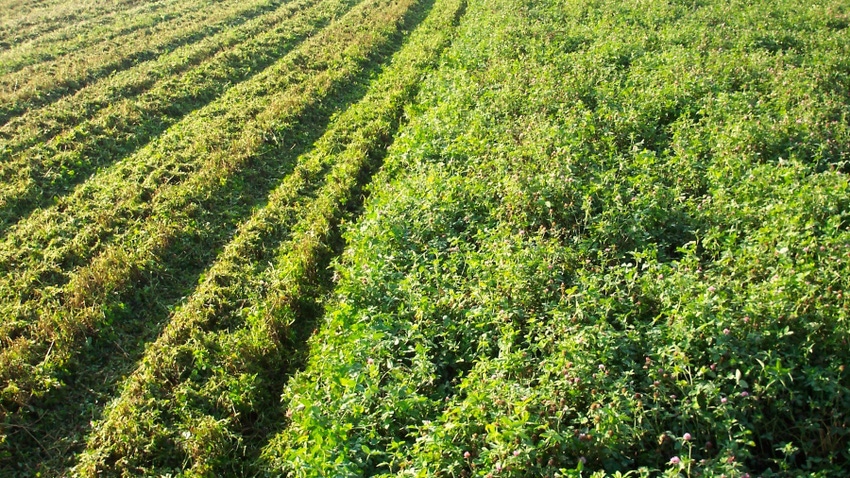
Jose Franco, agronomist at the U.S. Dairy Forage Research Center in Madison, Wis., says farmers have a lot more flexibility today with cover crops than they did just five or 10 years ago.
“Cover crops can both prevent soil erosion and be used as a forage,” he says. “We plant cover crops to slow erosion, improve soil health, enhance water availability, smother weeds, and help control pests and diseases. But they can also be grazed or harvested and fed to animals.”
One way they differ, Franco says, is in the seeding rate.
“You can reduce the seeding rate if you are planting cereal rye, for example, and you are using it strictly for cover,” he explains.
Franco says according to University of Wisconsin Extension recommendations, if you are planting cereal rye for a cover crop, seed at 40 to 60 pounds per acre. If you are planting it for an early spring forage to harvest in May, increase that rate to 80 to 100 pounds per acre.
“At Penn State, they found that seeding at the lower rate still achieves good weed suppression,” he says. “And with cereal rye, you can still plant green into it the following spring.”
Management considerations
Franco says if you are planting rye for a forage crop, you will want to seed it early, in mid- to late August or September rather than in October.
“The seeding date can impact tiller production, and tiller production can account for up to 60% of biomass in the spring,” he explains. “It also may reduce the root production from that cover crop.”
Biomass production is important because as it increases, so does the potential to prevent soil erosion and retain nitrogen from the system.
Crop insurance
There are several crop insurance programs that encourage farmers to plant cover crops, including:
USDA Risk Management Agency Pandemic Cover Crop Program
USDA Risk Management Agency Prevented Planting Acres Program
Wisconsin Department of Agriculture, Trade and Consumer Protection crop insurance rebate, which pays a $5-per-acre rebate on cover crops
Environmental Quality Incentives Program, which pays $61.64 per acre and targets new adopters (one-year contract; five-year maximum)
Conservation Stewardship Program, which pays $10.28 per acre in a one-year contract for continuing adopters
What do these programs say about using cover crops for forages?
“They do allow harvesting or grazing of cover crops if this management doesn’t jeopardize the intended function for the cover crop and termination guidelines are followed,” Franco says. “You cannot harvest cover crops for grain if you are enrolled in these programs.”
Cover crops can be hayed, grazed or chopped at any time, he notes. Previously, farmers were required to wait until after Nov. 1 to harvest or graze cover crops.
“But they changed that, and now there is more flexibility when the crop can be hayed, grazed or chopped,” he says.
Farmers need to ensure that adequate cover remains, regardless of whether the crop is grazed, harvested or terminated.
“Leave at least 4 inches of residue after grazing, harvesting or terminating the cover crop,” Franco says. “It is good for snow capture in northern states like Wisconsin, and it reduces erosion potential in soils.”
Types of cover crops
Farmers can choose to plant grasses and small grains for cover crops, including annual ryegrass, winter cereal rye, triticale, barley, wheat, oats or sorghum-sudangrass.
“The benefits of planting grasses or small grains is they prevent soil erosion, build soil, fight compaction, boost nitrogen scavenging and increase forage value,” Franco says.
Another option is to plant legumes as cover crops, including hairy vetch, red clover, lentils or field peas.
“The benefits of having legumes in your system are they can act as a nitrogen source, they build the soil, prevent erosion, suppress weeds and boost forage value,” he says.
A third option is to plant brassicas as cover crops. These include turnips, kale, mustard, rapeseed and pennycress.
“Some of the benefits of brassicas include soil building, biodiversity supporting, nitrogen scavenging, weed suppression and fighting soil compaction,” Franco says.
When choosing a cover crop, you need to consider your goals with cover crops, your crop rotation, your tillage and manure management, as well as whether you want the plants to be actively growing.
“Cover crops can be utilized as a livestock feed source whether they are stored or grazed,” Franco says. “They provide an immediate return on investment while still allowing growers to take advantage of rebate programs. And value-added forage can be used as emergency or supplemental feed for livestock.”
About the Author(s)
You May Also Like






